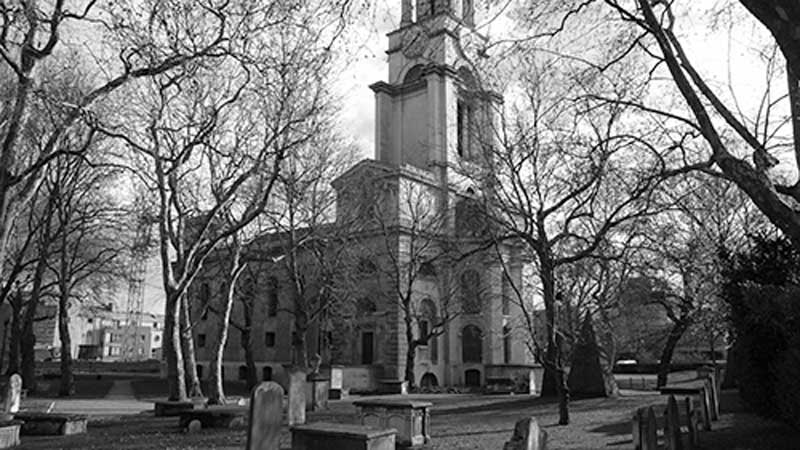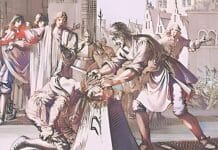EDDIE BRAZIL looks at the construction of urban folklore horror in the form of a murderous vicar from London’s east end
Early on a Sunday morning in July , 1971, three workmen were making their way along a deserted street in the Wapping district of East London, near the River Thames when they saw what appeared to be a figure dressed in strange clothes.
Closer inspection revealed the person was attired in the garb of a clergyman, but one which looked as if he was from the 18th, not 20th century.
The three men passed the gentleman, but got only so far when their curiosity compelled them to turn and take another look.
But when they did , the man was no where to be seen and the street was deserted.
The three men were convinced they had seen a ghost, and their relating of the experienced to others only confirmed it so.
They had seen the phantom evil Vicar of Ratcliff Wharf who was said to haunt the Wapping and Limehouse area of the river Thames.
During the 1770s he ran a seamen’s mission and, although being Vicar of St Anne’s, Limehouse, and looked upon as respected member of the local community for his good deeds, his true purpose was of a more nasty nature.

For he killed his guests for their money and disposed of their bodies into the murky waters.
His crimes were discovered and he was hung in chains at Wapping steps until three tides had passed over him.
Two hundred years on many people claimed to have seen the ghost of the evil cleric along the desolate riverfront.
Local people who worked on the river never went down to the wharf after it got dark.
Even the River Police were wary of venturing there at night.
Naughty children were told the Vicar would come for them if they continued to misbehave.
And over the shadowy glow of a late night pub fire, tales of St Anne’s evil clergyman chilled the bones of those who had to make their way home alone through Wapping’s lamp, lit street… and yet there was a problem with the tale; the whole story was a fabrication!
Vicar ghost invented by journalist Frank Smyth
There never was a murderous Vicar of Ratcliff Wharf or his ghost. The entire story was invented by journalist, Frank Smyth.
In 1975, Smyth who was a staff writer on the magazine, “Man, Myth and Magic” decided to invent a good old-fashioned ghost, and the derelict wharves seemed a perfect location for the mythical old vicar.
After the article appeared, other magazines and books often made reference to the Phantom Vicar who haunted the riverfront.
It was even featured in a TV special.
The reaction to the original story was such that it soon become accepted that there was a Phantom Parson, and even when Smyth tried to convince some old river workers that it was fantasy, they replied they had heard the story from their Grandfathers when they were boys.
During the five years from the articles publication to Smyth revealing the hoax to the Sunday Times eight people reported seeing the ghost of the Vicar.
Tale still talked about in Wapping 40 years later
Forty years on the evil deeds of the Clergyman and his haunting presence are still talked about in Wapping and Ratcliff Highway.
In short he has become part of east end supernatural folklore. But how is it possible for a fictitious tale and a fabricated ghost to become so embedded in the folklore of an area and the consciousness of its inhabitants?
Of course, Smyth had help in the first place.
His choice of location was the perfect backdrop to hang his tale of the murderous ghostly Vicar upon.
An area of, derelict warehouses, narrow streets and lamp lit lanes close to the gloomy banks of the Thames which became eerily deserted after dark.
It was an area crying out for a ghoul. Rupert Brook captured the atmosphere perfectly in his poem ”Shadwell Stair”.
I am the ghost of Shadwell Stair
Along the wharves by the water-house,
And through the dripping slaughter-house,
I am the shadow that walks there
Smyth was also aided in his hoax not only by the local history of Ratcliff wharf, but indeed that of the East End of London.
Jack the Ripper apart, this part of London has experienced its own spate of horrific murders chief of which are the Ratcliff Highway slayings of 1811.
In the space of 12 days, two families were slaughtered in their homes in such a terrible manner that for weeks afterwards people barricaded their doors, and eyed every stranger with suspicion.
With such a location and history Frank Smyth had only to add the story of the Vicar. The rest was inevitably filled in by willing believers and accepted by the local inhabitants; but why?
Why do people believe in folk tales?
The longevity and belief of folk tales, be they horror or otherwise, owe most to the oral traditions, customs and identity of the communities from which they evolved.
The term “Folklore” says a lot. It is “our story”. The tales are impervious to scrutiny or hard evidence, and they have to be.
Demolish a community’s lore and you demolish the folk. The stories, however outlandish, are part of the peoples culture. They are their murderers, their ghosts, their monsters, their bad guys. However horrid, repulsive or dubious the person, he is. or was, at least, one of us.
Therefore it is no surprise that Smyth’s tale of the Vicar of Ratcliff wharf was embraced without to much question.
Today, one wonders if the Vicar, or for that matter urban folklore, can survive in an ever changing area of multi-million-pound apartments and offices peopled by fleeting, “here today, gone tomorrow” residents climbing the property ladder who know little and care less about the history and culture of the east end of London. I fear not.
Read about the shocking Ratcliffe Highway murders here.







